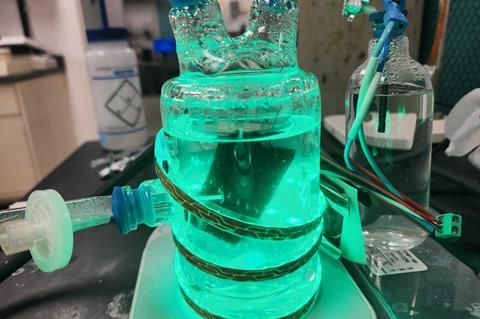Researchers at Michigan State University have identified an enzyme that is a limiting factor to microbial electrosynthesis by Shewanella oneidensis, a bacterium that could potentially capture carbon dioxide emissions to produce useful materials.
The study, ‘NADH dehydrogenases drive inward electron transfer in Shewanella oneidensis MR-1’, appears in Microbial Biotechnology, an Applied Microbiology International publication.
The team at Michigan State University are working to identify genes that contribute to electrically-driven bioproduction by bacteria and suggest ways to boost productivity by future strain engineering.
”The motivation for this project is to develop a bacterial strain that combines carbon dioxide with electricity from renewable sources to produce useful chemicals, fuels, or bioplastics,” says principal investigator Dr Michaela TerAvest.
“This process is called microbial electrosynthesis and has the potential to capture carbon dioxide emissions from industrial processes and help alleviate dependance on fossil fuels.”

In previous studies, the team found that the bacterium Shewanella oneidensis could accept electrons from an electrode and use them to drive cellular processes that make a targeted product.
”Here, we followed up on previous work and explored the bottlenecks that limit production of the target molecule. We found that NADH dehydrogenases, which are a key part of the respiratory chain, are one of the limiting factors,” Dr TerAvest says.
”To learn this, we cultured Shewanella in bioelectrochemical systems and provided them a constant feed of electrons from an electrode. We compared normal strains to those which had the NADH dehydrogenase genes deleted from the genome.
”Strains with the NADH dehydrogenases removed were unable to accept electrons from the electrode to produce the target molecule. This pointed to an essential role for NADH dehydrogenases in electron uptake.
”Some results also suggested that NADH dehydrogenases could be a rate-limiting step for electron uptake. Future work to upregulate these essential electron transfer complexes could result in improved microbial electrosynthesis capability in Shewanella or other microbes, bringing the process closer to industrially-relevant production levels.”
Michaela TerAvest, PhD, is the principal investigator and the experiments were led by lab manager Nicholas Tefft. This was supported by a Beckman Young Investigator Award from the Arnold and Mabel Beckman Foundation, a CAREER award from the National Science Foundation, and an NSF Graduate Research Fellowship to co-author Kathryne Ford.







No comments yet